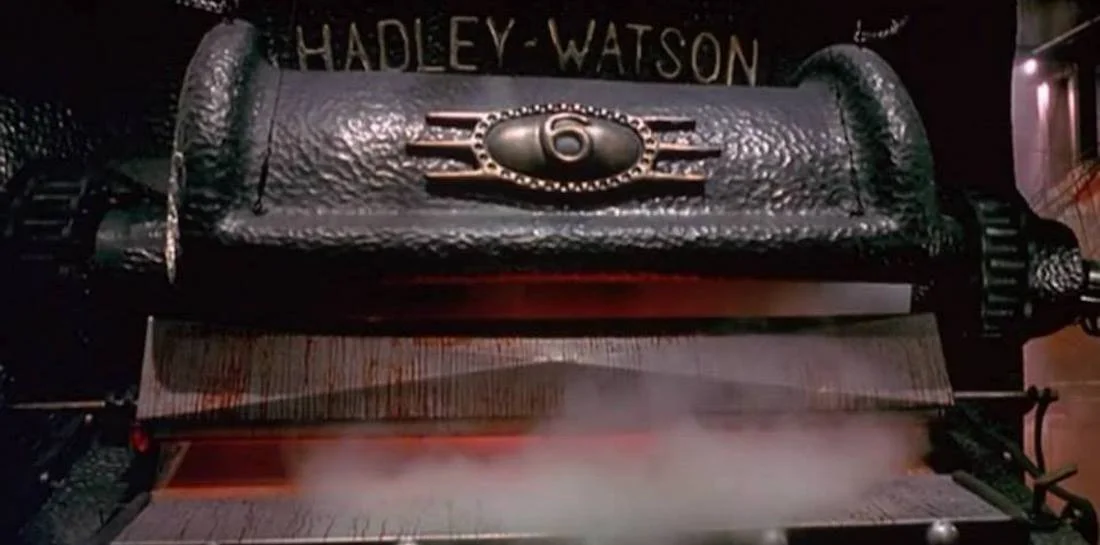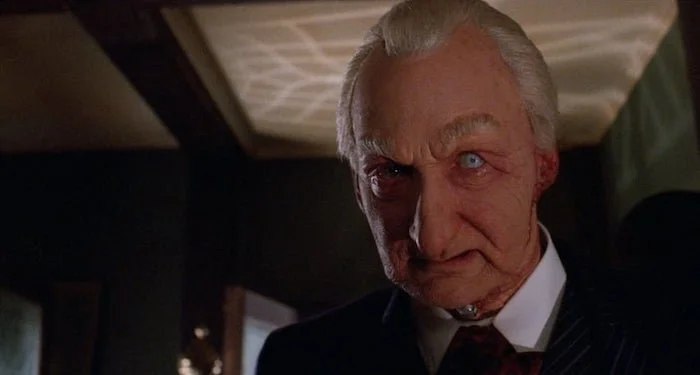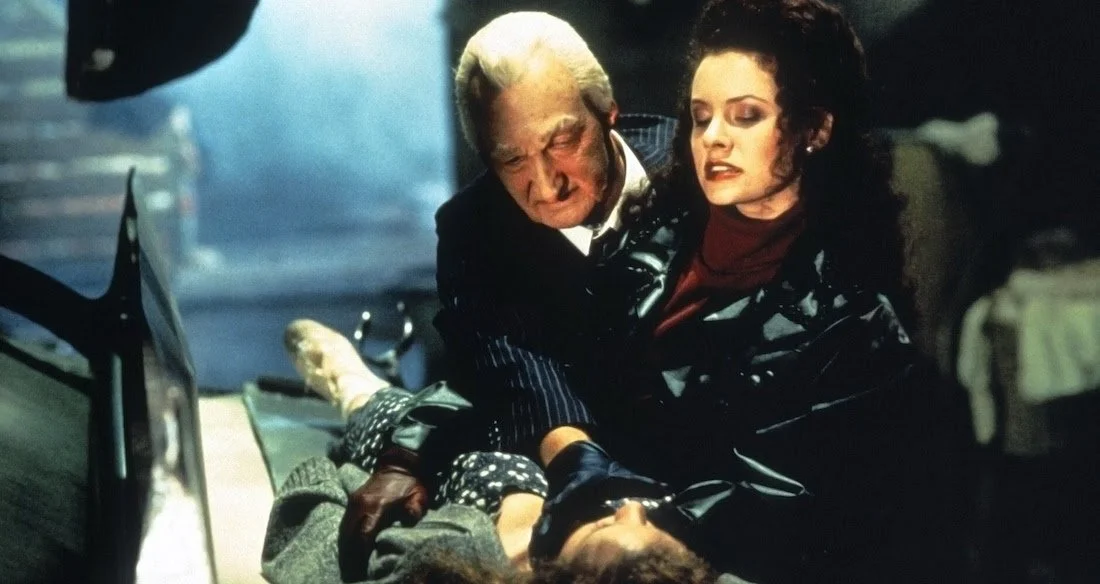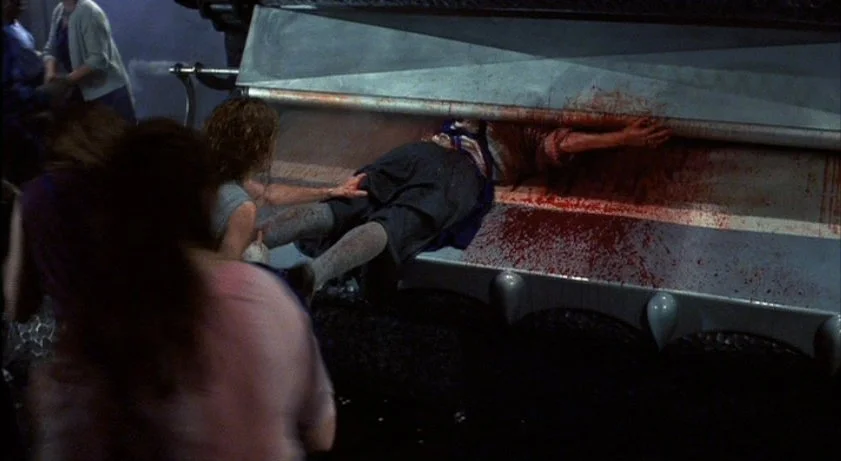The Pumpkin King: THE MANGLER (1995)
“If you mention it to anyone else, I’ll deny I said it. But I didn’t like that machine. It seemed… almost to be mocking us. I’ve inspected over a dozen speed ironers in the last five years on a regular basis. Some of them are in such bad shape that I wouldn’t leave a dog unleashed around them—the state law is lamentably lax. But they were only machines for all that. But this one… it’s a spook.” - Stephen King, “The Mangler”
In short horror story form, pitching “killer laundry equipment” is an indisputable winner. It’s a premise that’s as absurd as it is immediately intriguing, and for 30 pages, your average constant reader is eager to satisfy their curiosity.
There’s something irresistible about a talented, audacious person taking something like that seriously, especially, as is the case with Stephen King’s 1972’s “The Mangler” (originally written for Cavalier magazine in King’s lean pre-CARRIE years, later collected in 1978 for his enormously popular Night Shift anthology, his first short story collection), when it absolutely delivers on the title’s promise of a galore of gore. So much blood and guts are folded into this thing, in fact, that it walks that razor’s edge between something truly horrifying and slapstick carnage. I’ve decided to dub this phenomenon “Gore Blimey.”
As fun as the idea is for a short story, once it enters the landscape of the feature-length motion picture, the logline alone of THE MANGLER encourages skepticism and even derision.
The title alone practically challenges you: How seriously are you gonna take this one?
Well, come the mid-90s, enough people decided that it was worth a real chance. No TV miniseries here: 1995’s THE MANGLER got itself misunderstood genre legend Tobe Hooper to helm an entire 105 minutes of effects-heavy killer folding machine action.
Now, in the 1990s, Tobe Hooper was not in the prime of his career when it came to critical acclaim or box office draw. While I’ll go to bat any day for SPONTANEOUS COMBUSTION’s electric, unsubtle charms, the troubled shooting and reception of ‘93’s NIGHT TERRORS was a glum entry in a career that, while fascinating as hell to fans, was absolutely not capturing the zeitgeist nor the imaginations of your average popcorn chomper post-POLTERGEIST. This glumness crept into THE MANGLER, and frankly, I think it may be the secret ingredient that helped make this film a lot more interesting than it’s been given credit for.
A big part of Hooper’s draw is that he’s as funny as he is cynical and dark. Whether more overt (THE TEXAS CHAIN SAW MASSACRE 2) or inscrutable (the bombastic exploitation epic EATEN ALIVE, which seems to borrow as much from Tennessee Williams and Peyton Place as it does from grindhouse-era 42nd Street on its meanest, ugliest day), if someone really, really wanted to attempt a film adaptation of the story of a bloodthirsty speed ironer and folder, Hooper was pretty much the only guy I think most would trust.
To my mind, Hooper’s perceived failures are still interesting and have at least one angle that could have only come from him.
Mix that with the marquee names of Stephen King and a horror movie icon (Robert Englund, returning to work with Hooper from EATEN ALIVE, Freddy’s Nightmares, Masters of Horror and NIGHT TERRORS), THE MANGLER had a fighting chance at becoming a real cult classic.
The plot doesn’t mince meat when it comes to why this industrial equipment is suddenly so dang bloodthirsty. It’s a tale as old as time: Spilled virgin blood in a non-fatal accident whet its appetite for human flesh, and antacids that contain a derivative of belladonna get into the machine as well, obviously awakening an insatiable demonic force of evil the likes of which the Maytag repairman had never seen. If you put money on the fact that powerful people in this otherwise sleepy little town have a big, bad secret about how they keep their power strong by feeding the thing, I have some good news for your bookie.
You take a story like that, plop cop John Hunton (Ted Levine, at this point now a known character actor from his THE SILENCE OF THE LAMBS triumph and gnawing the scenery with admirable gruffness and energy) in the middle of it, and pair him up with his pragmatic demonologist brother-in-law (Daniel Matmor, also returning from Hooper’s NIGHT TERRORS), and you’re already cooking up a pretty fun normies-meet-an-ultimate-evil paranormal caper.
The Mangler itself is a gigantic, formidable bit of gothic architecture that was designed for the film by William Tony Hooper, Tobe’s son. Impressive as it is, they wisely added a human villain to get some more acidic dialogue in the mix. Enter Englund’s Bill Gartley, the soulless owner of Gartley's Blue Ribbon Laundry. No neophyte to ghoulish accouterments, Englund doesn’t let himself get buried under contacts, an eyepatch, latex makeup, and two leg braces and canes. Instead, he leans in on becoming the personification of OSHA’s worst nightmares by supplying poor working conditions, encouraging his overseer to be as abusive as he is, and taking part in sacrifices while just overall being an evil sonofabitch who barks instead of talks.
Like many Stephen King properties, we get a Big Ending that gets Plenty Awkward. The imagination of a reader is only limited by their own brain. With no budget and no one to reign us in, we constant readers are almost as much a participant in making the horror come alive as the author is. Translating that to film is tricky on a good day, and once we get to ‘90s CG making the Mangler actually haul itself up and chase people, well, anyone without a high tolerance for cheese and a generous spirit might find themselves wanting… well, something that’s not a sentient laundry press that’s on the lam.
THE MANGLER is flawed and pretty silly. However, that’s not all it is. It’s also an impressive exercise in building an entire, distinctive world on a small budget. Beyond the hellish laundry setting, the town and sets that surround it have a sultry atmosphere to them. THE MANGLER was largely filmed in South Africa, and like many films set in the United States but filmed elsewhere, it feels just “off” enough to keep your eyes riveted when they’re not potentially rolling. There’s a real sense of darkness and dread attached to this that goes beyond the impressive gore and smoke machines, that kind of playful, nasty darkness of which Hooper was the underappreciated master. While Hooper’s other King, SALEM'S LOT, is better regarded and known, I’m partial to how wild and wooly he gets here.
When Stephen King adaptations work, they become towering pillars of the horror genre and renew the hunger for more to get produced, keeping Maine’s favorite boy evergreen. When they go very badly, they become clumsy, greedy embarrassments that either bear very little resemblance to the source material or somehow mine only its weaknesses and none of the charm. Between those lies the valley where THE MANGLER peacefully rests: Uneven but fascinating, effective as a mood piece more than a straightforward terrifying concept, full of very talented people working off source material that didn’t lend itself to making a cinematic approach feasible, let alone easy, it manages to be fun and intriguing more often than it’s anything else.
No, THE MANGLER most likely won’t sidle up and steal the top spot as the most overlooked King riff or the forgotten Tobe Hooper masterpiece, but it’s a sincere, strange, lonely monster that deserves a visit, a revisit, or at the very least, a bit of a fluff & fold before it’s put back on the shelf.






